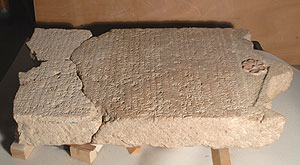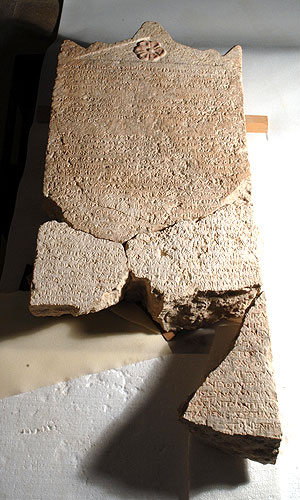
The Heliodoros Stele - with all of its pieces restored - photograph Peter Lenny, Israel Museum Jerusalem
The inscriptions, found by Dr. Ian Stern of "Archeological Seminars" at an Israel Antiquities Authority excavation, relates to the Maccabean revolt
A royal Greek inscription- "The Heliodoros stele"- consisting of 28 lines inscribed on limestone, was exhibited at The Israel Museum, Jerusalem, two years ago, on extended loan from Michael and Judy Steinhardt, New York. It is considered one of the most important ancient inscriptions found in Israel. Recently, three smaller fragments of a Greek inscription were found at an Israel Antiquities Authority excavation at Maresha, located inside the National Park of Beit Guvrin, under the supervision of Dr. Ian Stern and Bernie Alpert. Dr. Dov Gera (Ben Gurion University of the Negev), who studied the inscriptions shown to him by Dr. Stern, determined that the fragments were actually the lower portion of "The Heliodoros stele". This discovery confirmed the assumption that the stele originally stood in one of the temples in Maresha- Beit Guvrin National Park today. The new fragments were discovered in a subterranean complex by participants in the Archaeological Seminars Institute's "Dig for a Day" program.

The Heliodoros Stele - with all of its pieces restored - photograph Peter Lenny, Israel Museum Jerusalem
As published by Professor Cotton and Wörrle, in 2007, this royal stone stele bears a proclamation by the Seleucid king, Seleucus IV (brother of Antiochus IV), and dates to 178 BCE. The contents of the stele shed light on the Seleucid government's involvement in local temples, mentioning an individual named Olympiodoros, the appointed "overseer" of the temples in Coele Syria – Phoenicia, including Judea. The order of the king was sent to Heliodorus, who was probably the same person mentioned in II Maccabees 3. According to the story in Maccabees, Heliodorus, as the representative of King Seleucus IV, tried to steal the wealth from the Temple in Jerusalem but instead was severely beaten as a result of divine intervention. Three years later Seleucus IV was assassinated and was succeeded by his brother Antiochus IV, who was the ruler who according to II Maccabees eventually issued an edict of persecution against the Jewish people and desecrated the Temple in Jerusalem leading to the Maccabean Revolt.
In short, it can be determined that this royal stele originated in the city of Maresha, and adds important archaeological evidence and historical context for understanding the period of time leading up to the Maccabean Revolt, an event celebrated each year on the holiday of Hanukah. Dr. Ian Stern, excavation director on behalf of the Israel Antiquities Authority adds, “this discovery is the fruit of a joint effort on the part of the Archaeological Seminars Instititute’s “Dig for a Day” program, the Israel Antiquities Authority and the staff of the of the Israel Nature and Parks Authority in the National Park of Beit Guvrin”.
The stele at The Israel Museum has been published by H. Cotton and M. Wörrle (2007, Zeitschrift für Papyrologie und Epigraphik) and the portion found in the Maresha excavation will be published soon by D. Gera (forthcoming, Zeitschrift für Papyrologie und Epigraphik( .
For further information:
Omri Gal, Israel Nature and Parks Authority, 057-2212270
Meyrav Shay, Israel Antiquities Authority, 052-4284408, meyrav@israntique.org.il
Additional Articles ...